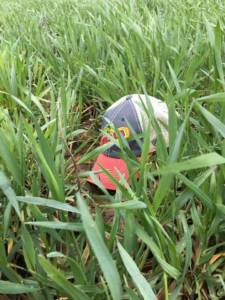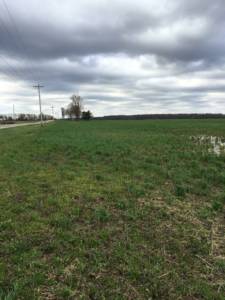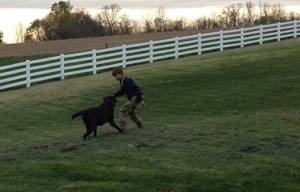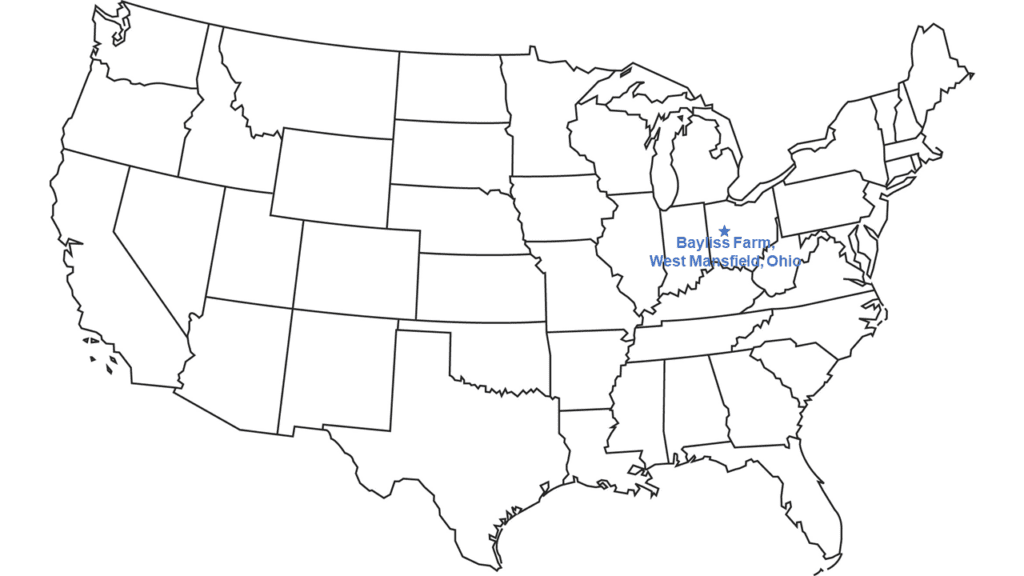This spring has brought very typical weather to our area of Ohio. We have a few days of beautiful, warm, sunny weather, followed by a few days of cold, cloudy, rainy weather. Because of that pattern, the soil is not quite firm enough to allow us to start fieldwork yet. If the weather cooperates, we hope to be able to work in our fields next week.
Our first priority in the field will be to apply nitrogen fertilizer to our soft red winter wheat, which looks good and is growing well.
 We planted some fields to a rye cover crop last fall, and it is also growing well. In fact, the rye is over 30 cm, or 1 foot, tall. That’s the most growth we’ve seen since we started incorporating cover crops into our system a few years ago. That’s great, but it also creates challenges. Before we plant those fields, my son-in-law David and I have to decide how we want to handle that vegetation.
We planted some fields to a rye cover crop last fall, and it is also growing well. In fact, the rye is over 30 cm, or 1 foot, tall. That’s the most growth we’ve seen since we started incorporating cover crops into our system a few years ago. That’s great, but it also creates challenges. Before we plant those fields, my son-in-law David and I have to decide how we want to handle that vegetation.
We can either terminate the cover crop before planting or plant into the cover crop while it is still green and growing. Each option has pros and cons, and because we haven’t worked with a cover crop that has grown this much, we have limited experience.
Cover crops boost soil organic matter content and help keep soil in place. When planting a crop, the seeds need to have firm contact with the soil, without air pockets around them, to ensure that they germinate and emerge.
If we burn down, or use herbicide to kill the ryegrass, before we plant, we should be able to ensure good seed-soil contact when planting. But if we get significant rains between burndown and planting, we could end up with a heavy mat of vegetation over the soil that will keep it too wet to plant. We could even run the risk of needing to do some tillage to help the fields dry out and warm up enough for planting.

If we choose to plant into a green cover crop, the soil will get more benefits from the cover crop roots, but it will be harder to ensure we get seed-soil contact needed for the new crop to grow well. We need to ensure that our main crop will get a good start. With this approach, we would terminate the cover crop after the fields have been planted.
Right now, we are evaluating our options based on our experience with our soil types, weather and more. And we will decide within the next week how we will manage this challenge, and then use what we learn to improve the following year.
We will plant corn and soybeans as soon as the conditions allow. Usually we start with corn, but if soil temperatures remain cool, we will plant soybeans first. We have found that soybeans handle lower soil temperatures better in our fields.
We prefer to plant corn and soybeans in a no-till system, but occasionally we have areas in the field that need to be smoothed out to ensure that the seeds get the firm soil contact they need, and then we will do a little bit of conservation tillage, just where needed.
While we are waiting to get into the fields, David has been continuing to care for his cattle, building fences, caring for new calves as they are born and building a new cattle shed. We’ve also been getting equipment ready to go. In fact, after Ohio’s stay-at-home order was issued to slow the spread of COVID-19, we learned that David one of the last people who went inside our local equipment dealership to pick up parts. After that order was issued, farmers were encouraged to call ahead so the dealership could have parts ready for pick-up. Thankfully, this type of business is slowly evolving back toward normal.
 The stay-at-home order has changed a few other things for our family. Jana and David, my daughter and son-in-law who farm with me, have their oldest daughter home from college and taking classes online. Their second daughter, a senior in high school, and their 14-year-old son are also doing schoolwork online. They are sticking close to the farm, though my grandson and his Black Labrador have appreciated the additional time to go hunting.
The stay-at-home order has changed a few other things for our family. Jana and David, my daughter and son-in-law who farm with me, have their oldest daughter home from college and taking classes online. Their second daughter, a senior in high school, and their 14-year-old son are also doing schoolwork online. They are sticking close to the farm, though my grandson and his Black Labrador have appreciated the additional time to go hunting.
We realize there has been a disruption in the way we do business because of COVID-19, but we are still growing soybeans and other crops. And we will be in the fields to do that very soon.

